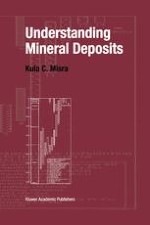2000 | OriginalPaper | Buchkapitel
Formation of Mineral Deposits
verfasst von : Kula C. Misra
Erschienen in: Understanding Mineral Deposits
Verlag: Springer Netherlands
Enthalten in: Professional Book Archive
Aktivieren Sie unsere intelligente Suche, um passende Fachinhalte oder Patente zu finden.
Wählen Sie Textabschnitte aus um mit Künstlicher Intelligenz passenden Patente zu finden. powered by
Markieren Sie Textabschnitte, um KI-gestützt weitere passende Inhalte zu finden. powered by
All the common ore-forming elements are present in magmas and ordinary rocks, in amounts ranging from a few parts per billion to several thousands of parts per million (Table 2.1). The formation of a mineral deposit represents the convergence of a set of favorable circumstances leading to a significantly higher concentration of one or more elements in a limited portion of the Earth’s crust. The required concentration factor, which is defined as the ratio of the average concentration of an element in a mineable mineral deposit to its average crustal abundance, is highly variable and depends not only on the particular element but also on the type of deposit. The concentration factors range from about 5–10 for geochemically abundant elements (e.g., aluminum and iron) to about 100–1,000 for less abundant elements (e.g., copper, zinc, and uranium). It is indeed remarkable that geologic processes, which normally result in further dispersal of trace elements, have been able to produce mineable deposits of geochemically scarce elements, such as gold and mercury, involving concentration factors in the thousands.
